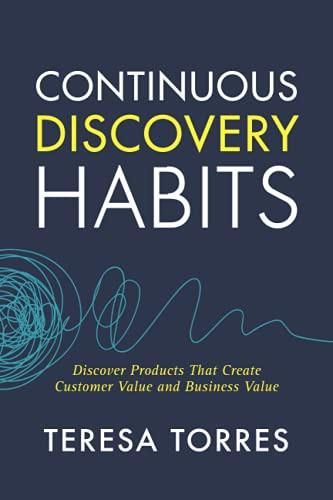Explore the World's Best Ideas
Join today and uncover 100+ curated journeys from 50+ topics. Unlock access to our mobile app with extensive features.
Continuous Discovery Habits
- Follow the “continuous discovery” process to structure the way you make decisions, implement research and create strong product testing.
- Set a clear goal to guide your product team through discovery.
- Map out your customer experience to discern potential solutions.
- To craft solutions, prioritize customers’ needs, issues and desires.
- Identify hidden assumptions that support or kill your solutions.
- Test your assumptions to minimize risk and make sure you’re on track.
- Collaborate with stakeholders as you cycle through the discovery process.
9
149 reads
Follow the “continuous discovery” process to structure the way you make decisions, implement research and create strong product
Implement a structured, continual discovery process to develop new products that achieve your goals. This strategy will:
- Eliminate clashes between stockholders’ needs and customers’ needs by creating value for both.
- Foster a shared understanding among the members of your product team about how to reach desired results.
- Teach team members how to use a continuous development mind-set in product testing.
- Support better decision making.
- Boost team members’ confidence that they know what to do if things go wrong.
6
71 reads
Set a clear goal to guide your product team through discovery.
“It starts with defining a clear outcome – one that sets the scope for discovery.”
6
80 reads
Map out your customer experience to discern potential solutions.
As a team, draw a shared experience map in five steps:
- Turn each individual experience map into a collection of events and the sequential links that connect them.
- Create a new map that encompasses all the group’s actions or events.
- Combine similar events.
- Redraw the links among events to capture any disruption in the flow of the experience, so that you support longer viewing spans. A disruption occurs, for example, when people can’t easily find the show they want.
- Incorporate what the customer might be thinking, feeling or doing at each step.
6
46 reads
To craft solutions, prioritize customers’ needs, issues and desires.
To create branches that connect the remaining opportunities:
- Group similar customer needs together on one level.
- Look for the larger underlying need that encompasses this group of similar ones, and place that larger need above its cluster.
- Seek similarities among the larger opportunities, and cluster those.
- Repeat these steps until you identify a few top opportunities from which all the others descend.
6
43 reads
Prioritize which opportunity to solve:
- Compare sets of similar customer needs by asking how many customers each one affects, and how often it affects them.
- Consider how each opportunity positions you against your competitors.
- Consider whether addressing the problem supports your vision, mission or strategic objective.
- Focus on opportunities that lead to the greatest customer satisfaction.
- Pick an opportunity.
7
49 reads
Identify hidden assumptions that support or kill your solutions.
When you evaluate your three chosen solutions, ask what assertions underlie them that must be either true or false for your solution to work. Look for five types of assumptions:
- Desirability – Will your customers want to use your solution and gain value from it?
- Viability – Does your solution create value for your business?
- Feasibility – Is your solution technically workable?
- Usability – Will customers understand how to employ your solution?
- Ethical – Does your solution create any potentially harmful impact?
7
45 reads
Test your assumptions to minimize risk and make sure you’re on track.
Start with small-scale tests that follow three rules:
- Include a variety of people, but as few as possible. For example, survey 10 people from 10 different states.
- Use product prototypes, one-question surveys or data mining you can complete in a day or two.
- Simulate an experience that lets test participants behave realistically in accordance with your assumption. For example, to forestall vague responses, write surveys with short questions that require a yes or no answer.
6
42 reads
Collaborate with stakeholders as you cycle through the discovery process.
When meeting with stakeholders:
- State your desired outcome or goal.
- Explain your interview process, guiding questions and the top customer opportunities you uncovered.
- Show how and why you prioritized each decision.
- Create empathy and understanding for the customer by sharing interview snapshots.
- Show your solutions, and ask the stakeholders for their ideas.
- Share your test results, and consider any feedback.
7
46 reads
IDEAS CURATED BY
CURATOR'S NOTE
Continuous discovery
“
Curious about different takes? Check out our Continuous Discovery Habits Summary book page to explore multiple unique summaries written by Deepstash users.
instructor Hood's ideas are part of this journey:
Learn more about habits with this collection
How to find purpose and meaning in life
How to cultivate gratitude
Techniques for managing negative thoughts
Related collections
Different Perspectives Curated by Others from Continuous Discovery Habits
Curious about different takes? Check out our book page to explore multiple unique summaries written by Deepstash curators:
13 ideas
9 ideas
13 ideas
Discover Key Ideas from Books on Similar Topics
10 ideas
Product-Led Growth
Bush Wes
9 ideas
Founder Brand
Dave Gerhardt
13 ideas
The Ultimate Marketing Engine
John Jantsch
Read & Learn
20x Faster
without
deepstash
with
deepstash
with
deepstash
Personalized microlearning
—
100+ Learning Journeys
—
Access to 200,000+ ideas
—
Access to the mobile app
—
Unlimited idea saving
—
—
Unlimited history
—
—
Unlimited listening to ideas
—
—
Downloading & offline access
—
—
Supercharge your mind with one idea per day
Enter your email and spend 1 minute every day to learn something new.
I agree to receive email updates

